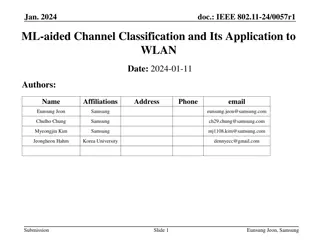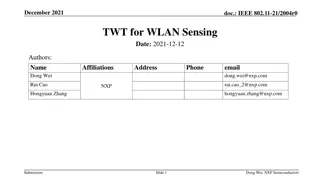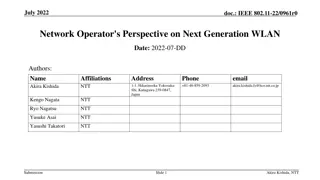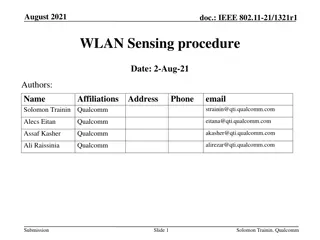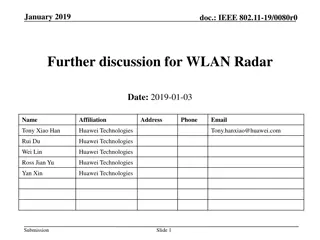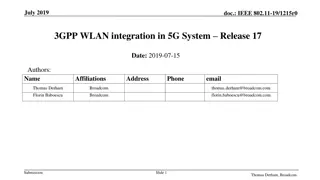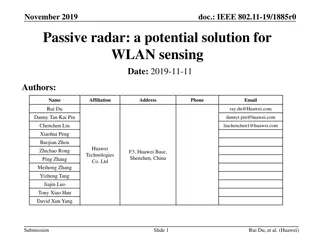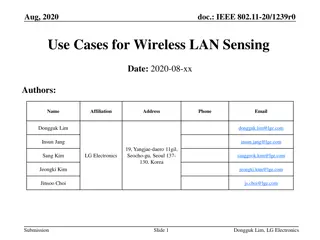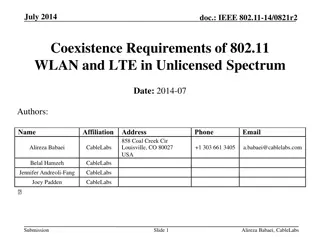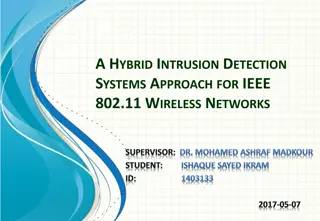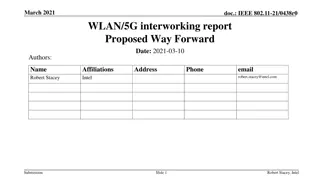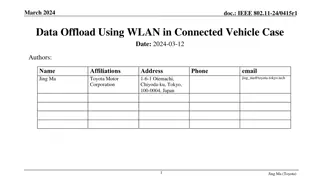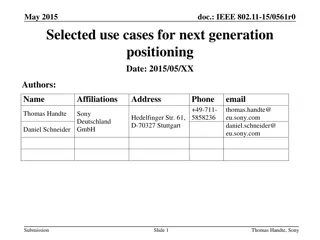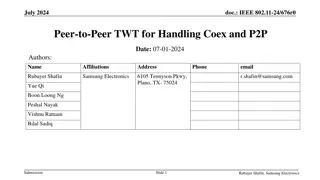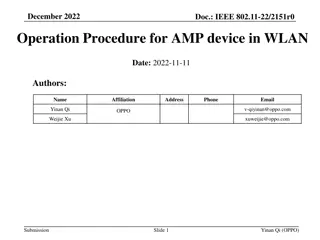WLAN Backhaul Options for Next-Generation Wi-Fi Networks
IEEE 802.11-23/0677r0 explores various backhaul options for WLAN, emphasizing Fiber to the Room (FTTR) technology based on Passive Optical Network (PON) for enhancing the performance of multi-AP coordinated next-gen Wi-Fi UHR. The document discusses wired and wireless backhaul connections, including Ethernet and G.hn, highlighting their advantages and limitations in different scenarios.
Download Presentation

Please find below an Image/Link to download the presentation.
The content on the website is provided AS IS for your information and personal use only. It may not be sold, licensed, or shared on other websites without obtaining consent from the author. Download presentation by click this link. If you encounter any issues during the download, it is possible that the publisher has removed the file from their server.
E N D
Presentation Transcript
May 2023 doc.: IEEE 802.11-23/0677r0 WLAN Backhaul Options Date: 2023-05-16 Authors: Affiliations Address Futurewei Technologies Futurewei Technologies Futurewei Technologies Phone email Name Andy Shen ashen1@futurewei.com Frank Effenberger frank.effenberger@futurewei.com Yuanqiu Liu yuanqiu.luo@futurewei.com Submission Slide 1 Andy Shen (Futurewei Technologies)
May 2023 doc.: IEEE 802.11-23/0677r0 Introduction WLAN is an ubiquitous networking technology, and multiple APs are usually required to provide comprehensive coverage for home/business application. Multi-AP coordination is an important candidate feature for next generation Wi-Fi UHR, and there are discussions to address the impact of backhaul to fronthaul performance. Backhaul connection can be wired or wireless, each with its advantages and disadvantages. This contribution examines different connection types used for backhaul link, with emphasis on FTTR (Fiber to the room) which is a new technology in development based on PON (Passive Optical Network). Submission Slide 2 Andy Shen (Futurewei Technologies)
May 2023 doc.: IEEE 802.11-23/0677r0 Wi-Fi Backhaul Wireless backhaul is commonly used at home, and multi-APs will be linked via mesh network. It is flexible in placement location, while it may be less reliable due to interferences. The wireless backhaul can be assigned to shared or dedicated Wi-Fi channel. Shared link will support both fronthaul and backhaul traffic, while dedicated link will only be used for backhaul traffic. There are studies that showed shared wireless backhaul or dedicated wireless backhaul with shared antennas may severely impact the fronthaul performance [1-3]. In addition, backhaul rate should be much higher than fronthaul rate. Submission Slide 3 Andy Shen (Futurewei Technologies)
May 2023 doc.: IEEE 802.11-23/0677r0 Wired Backhaul: Ethernet Wired backhaul is best from performance and reliability perspectives, and some common wired backhaul options are presented. Ethernet is the most popular wired connection, and it can be used to provide reliable backhaul link. Popular Ethernet speed is 1 Gbps, which may be limiting when future Wi-Fi Standards (Wi-Fi 7/8) can reach tens of Gbps. New routers on the market start to offer multi-Gig Ethernet port supporting 2.5G/5G/10GBASE-T speed. These are currently only in high end routers, but they will become more popular in the future to match the faster Wi-Fi speed. Most homes are not pre-wired for Ethernet, and thus the usage may be limited. In enterprise environment, Ethernet connection is common and will facilitate the AP placement. To support 10 Gbps speed, Ethernet cables may need to upgrade to Cat6a/Cat7. Ethernet switches will also need to upgrade, so it is a costly task and need careful planning. Submission Slide 4 Andy Shen (Futurewei Technologies)
May 2023 doc.: IEEE 802.11-23/0677r0 Wired Backhaul: G.hn G.hn is an ITU-T specification for high-speed home network [4]. It can operate on telephone wiring, coaxial cables, power lines and plastic optical fiber. Latest amendments to the G.hn family of Standards (G.996x) enable speed up to 10 Gbps over coaxial cable and 5 Gbps over phoneline. Except for the plastic optical fiber, the main advantage of G.hn is the wide availability of the wired installation in the house. There will be power sockets everywhere in the house, however, the performance may vary widely depending on the circuit wiring and electrical loading. In addition, the powerline adaptors must be in the same circuit. Coaxial and telephone sockets are also available in most houses, but much less than power sockets. They will probably provide decent performance, but the deployment rate is low and used for niche application. For business requiring consistent and reliable connection, Ethernet will be the preferred choice. Submission Slide 5 Andy Shen (Futurewei Technologies)
May 2023 doc.: IEEE 802.11-23/0677r0 Wired Backhaul: Fiber to the Room (FTTR) FTTR is an in-premise network technology that is based on optical fiber communication. FTTH (Fiber to the home) PON access (G-PON, XG- PON) provides high speed connection to premises (home, office, building etc), while FTTR is used inside the premise. PON service providers are interested in FTTR as it can provide end to end fiber services. ITU SG15 Q3 and CCSA (China Communication Standards Association) are developing Standards based on FTTR technology. Standards associations such as ETSI ISG F5G, BBF, CCSA and ITU-T sponsored workshops and published technical papers to promote FTTR technology [5-6]. Submission Slide 6 Andy Shen (Futurewei Technologies)
May 2023 doc.: IEEE 802.11-23/0677r0 FTTR for home (FTTR4H) The following figure showed the application of FTTR in home scenario. The MFU (Main FTTR Unit) terminates the PON access network and providing management and data services to the SFU (Sub FTTR Unit) MFU and SFU are connected via the IFDN (Indoor Fiber Distribution Network), which is a point to multipoint (P2MP) passive optical splitter. The split ratio may be different for home/business scenario, which affects the optical power link budget. The MFU and SFU will provide wireless (Wi-Fi) and wired (Ethernet) interfaces for end user services. Submission Slide 7 Andy Shen (Futurewei Technologies)
May 2023 doc.: IEEE 802.11-23/0677r0 FTTR for Business (FTTR4B) The following figure shows the application of FTTR for business scenario [7]. It is similar to FTTR4H, though multiple splitters may be used to extend to different floors, and the split ratio will be larger to support more SFUs. Optical and electrical hybrid cable can be used to provide remote power, facilitating flexible deployment of SFU. The split ratio may be uneven to provide more flexibility. Submission Slide 8 Andy Shen (Futurewei Technologies)
May 2023 doc.: IEEE 802.11-23/0677r0 Key Attributes of PON/FTTR PON and FTTR have similar architecture, both based on P2MP topology. The proposed FTTR line rates are symmetric 2.5G and 10G, which aligned with G-PON and XGS-PON. Uplink and downlink use different wavelengths to allow bi-direction transmission (WDM) on single fiber. The specific uplink and downlink wavelengths used depend on the PON system. PON frame duration is 125 us and OLT (optical line termination) sends downlink frame continuously. For uplink, ONUs (optical network unit) transmit data burst with duration and time position assigned by OLT, allowing multiple access (TDMA) without collision. ONU scheduled to send uplink burst will receive information in the downlink frame with the assigned timing. Instead of a fix bandwidth allocation to each ONU, OLT allocated bandwidth depending on the SLA (service level agreement) and buffer status feedback reported by each ONU. This is known as dynamic bandwidth assignment (DBA). This allows efficient use of bandwidth and gracefully supports bursty traffic pattern. OLT can manage and configure each ONU via the OMCI (ONU management and control interface) channel. OMCI provides the capabilities to perform configuration management, fault management, performance management and security management of the ONUs. Submission Slide 9 Andy Shen (Futurewei Technologies)
May 2023 doc.: IEEE 802.11-23/0677r0 Differences of PON and FTTR There are few differences for the two technologies i. The split ratio is lower for FTTR, proposed 1:8 for home and 1:32 for SME. PON is usually 1:64. ii. Fiber distance is < 1 km for FTTR while up to 20 km for PON iii. PON users are isolated from others and data are protected by encryption. FTTR4H is local network, and it may not need as much protection. FTTR4B may require security on par as PON network. iv. PON system is north-south traffic, while FTTR will have east-west traffic between different SFUs. MFU will route these east-west traffic. FTTR will adopt PON specifications as much as possible since it is a mature and proven technology. For instance, OMCI will be reused so that the OLT can manage each FTTR SFU, enabling operators to perform end to end network management. For physical media dependent (PMD) related requirements, specifications may be changed to reduce cost and complexity. For instances, FTTR maximum optical link loss will be smaller as the split ratio and fiber distance is less. This may allow using lower cost transceiver or simpler FEC. Submission Slide 10 Andy Shen (Futurewei Technologies)
May 2023 doc.: IEEE 802.11-23/0677r0 Centralized Coordination Network FTTR provides quality-assured in-premise network services to end users by enabling coordination between fiber link and wireless link as Wi-Fi data backhauling is one of the important use case for FTTR. The figure shows the centralized coordination network architecture of FTTR [8]. MFU controller collects network transmission demand (data buffer, priority, latency requirements, etc) and channel conditions (SNR, interference, etc) to make coordination strategy. One or more coordinators that: Coordinate AP transmissions Coordinate BH/FH characteristics Wi-Fi management SAP (defined outside ITU-T) QoS channels Scheduling / Time alignment Capabilities G.fin management SAP (defined in ITU-T) QoS channels Scheduling / Time alignment Capabilities Access Network Main FTTR Unit Sub FTTR unit End user NT Local coordinator User app Controller(s) Wi-Fi STA G.fin Wi-Fi AP G.fin Eth Eth Wi-Fi AP transceiver transceiver Sub FTTR unit End user Local coordinator User app Wi-Fi STA G.fin Wi-Fi AP Eth transceiver Submission Slide 11 Andy Shen (Futurewei Technologies)
May 2023 doc.: IEEE 802.11-23/0677r0 Centralized Coordination Network The MFU controller forwards control commands through the G.fin transceiver to each SFU to dynamically configure the network interfaces. For instances, coordinate the time/frequency/space of each SFU AP to align the air interface transmission. The controller coordination algorithm and the command protocol are vendor specific. Wi-Fi EasyMesh [9] is a popular mesh AP configuration tool which can support some of the MFU controller functionalities. The diagram shows the operation of EasyMesh via the multi-AP controller and agent interaction over the Wi-Fi and Ethernet backhaul. For 802.11 UHR multi-AP coordination (Co- OFDMA, null steering, joint transmission and reception etc), coordination will be more complicated, and the requirements to be determined. Submission Slide 12 Andy Shen (Futurewei Technologies)
May 2023 doc.: IEEE 802.11-23/0677r0 FTTR pros and cons as home/enterprise network backhaul Pros IFDN provides high bandwidth, future proof network supporting future upgrade Fiber is reliable with very long lifetime. Lightweight and small size leading to easier deployments. Performance not affected by EMI. DBA can provide consistent data packet delivery without outlier latency End to end management from access to home. PON service providers may resolve problem remotely without service visit reducing cost and better customer satisfaction. Cons Need front-end cost to install IFDN MFU/SFU will be more expensive than residential gateway/AP with the extra optical modules Service providers not using PON access (i.e. cable) less likely to endorse Submission Slide 13 Andy Shen (Futurewei Technologies)
May 2023 doc.: IEEE 802.11-23/0677r0 Conclusion Next generation Wi-Fi with Multi-AP feature may have new requirements on the backhaul. The impact of sharing fronthaul and backhaul traffic on the same channel may be significant. A dedicated backhaul will be desirable, both wireless and wired options can be used. Wireless backhaul is convenient to set up, but performance will depend on interference. Wired backhaul will have better performance, but require front-end cost to install wiring. Cost is an important factor for home backhaul choice, while business may consider reliability and performance as more important. More studies are needed to identify the management, signaling and data-plane requirements for Multi-AP feature. Based on these requirements, backhaul options suitable for different user scenarios can be recommended. Submission Slide 14 Andy Shen (Futurewei Technologies)
May 2023 doc.: IEEE 802.11-23/0677r0 References 1. 2. 3. Joint Transmissions: Backhaul and Gain State Issues , IEEE 802.11-19/1089 Multi-AP backhaul analysis, IEEE 802.11-19/1588 C-OFDMA throughput analysis in various mesh backhaul scenarios , IEEE 802.11-22/1567 Architecture, functions and services of home network , ITU-T GSTP-HNAFS GSTP-FTTR Use cases and requirements of fiber-to-the-room (FTTR) , ITU- T technical paper April 30 2021 First & Second Joint ETSI ISG F5G, BBF, CCSA TC6 and ITU-T SG15 Workshop on FTTR , ITU-T Workshops and Seminars Use case and requirements of fibre-to-the-room for small business applications , ITU-T G Suppl. 78 High speed fibre-based in-premises transceivers - system architecture , ITU-T G.fin-SA draft text Wi-Fi EasyMesh Specification v5.0 , Wi-Fi Alliance 4. 5. 6. 7. 8. 9. Submission Slide 15 Andy Shen (Futurewei Technologies)



